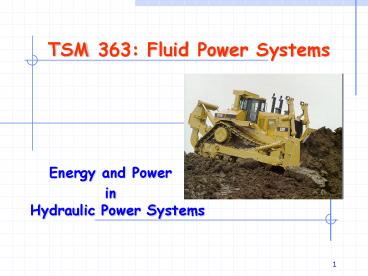TSM 363: Fluid Power Systems - PowerPoint PPT Presentation
1 / 18
Title:
TSM 363: Fluid Power Systems
Description:
Energy and Power in Hydraulic Power Systems Goals of this Lecture Fluid Power Energy Transmission Critical Facts of Hydraulic Systems Power is transmitted by pushing ... – PowerPoint PPT presentation
Number of Views:435
Avg rating:3.0/5.0
Title: TSM 363: Fluid Power Systems
1
TSM 363 Fluid Power Systems
- Energy and Power
- in Hydraulic Power Systems
2
Goals of this Lecture
- Fundamentals of Hydraulic Power Transmission
- Multiplication of force
- Conservation of energy
- Continuity of fluids
- Energy and Power in Hydraulic Systems
- Energy conversion in hydraulic systems
- Hydraulic power and efficiency
3
Fluid Power Energy Transmission
- vo, Fo
- P1, Q1
- P4 Q4
- ni, Ti
- M
PM-in
PH-in
- no, To
PH-out
PM-out
- Energy Level
4
Critical Facts of Hydraulic Systems
- Power is transmitted by pushing pressurized
liquids in a confined system. - Liquids form in the shape of the container with
equal pressure in all directions. - Hydraulic fluids can be considered incompressible.
5
Multiplication of Force
Pascals Law
6
Try This Together!
- A hydraulic cylinder has a diameter of 2.5
inches. Compute the area of the piston. - What pressure is developed lifting a 8836 lbf
load? - What is the pressure in Pascals?
7
Solutions
8
Conservation of Energy
Bernoullis equation
9
Conservation of Energy (Cont.)
Orifice equation
10
Example
- The pressure drop between the upstream flow and
the in-orifice flow as shown above is 1.0 MPa. - Compare the flow rate passing through the orifice
when a sharp-edged orifice of 10 mm in diameter
(Assume the specific fluid gravity is 900 kg/m3).
11
Solutions
12
Continuity of Fluids
flow continuity equation
13
Try It by Yourself After Class
- For a pipeline of D125mm, D215mm, and
v12.0m/s, try to find (a) the volumetric flow
rate Q, and (b) the fluid velocity at cross
section 2. - Hint According to the fluid continuity
principle, the volumetric flow rate should be the
same regardless of the size of the pipe cross
section if the fluid between the two cross
sections is confined.
14
Energy Conversion in Hydraulic Systems
15
Mechanical and Hydraulic Power
Mechanical power
Hydraulic power
16
Example and Try It Together
A hydraulic pump delivers pressurized fluid at 50
L/min and 9,000 kPa. How much hydraulic power
can this pump deliver? If the overall efficiency
of this pump is 90, how much mechanical power is
needed to drive the pump? If all the pressurized
fluid is delivered to a motor to drive a load,
what is the maximum useful power the motor can
deliver if the motor has the same overall
efficiency as the pump?
17
(a) The hydraulic power the pump can deliver
(b) The mechanical power needed to drive the pump
(c) The mechanical power available at the motor
for driving the load
18
Lecture Summary
- Discussed a few basic theoretical equations, and
their applications in hydraulic systems - Multiplication of force
- Conservation of energy
- Continuity of fluids
- Hydraulic power and efficiency































